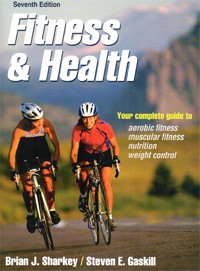Fitness & Health, 7th ed.
|

|
| Author: |
Sharkey BJ, Gaskill SE |
| Category: |
Health/Fitness |
| Audience: |
Consumer |
| Length: |
445 pages |
| Publisher: |
Human Kinetics |
| Year Published: |
2013 |
| List Price: |
$37.00 |
|
|
|
|
AthleteInMe.com® Rating:


 Good
Good
The 7th edition of Fitness & Health is a comprehensive resource on exercise and fitness training for weekend warriors.
• Recommended for: All adults, at any fitness level.
ABOUT THE AUTHORS
• Brian Sharkey, PhD, is an exercise physiologist. He earned his PhD in exercise physiology from the University of Maryland. He served as the director of the Human Performance Laboratory at the University of Montana and was dean of the College of Human Performance at the University of Colorado. Dr. Sharkey is a past president of the American College of Sports Medicine and coordinated the Sports Medicine Council for the US Ski Team.
• Steven Gaskill, PhD, is also an exercise physiologist. He is a professor in the department of health and human performance at the University of Montana. Dr. Gaskill was the head coach for the US Nordic ski team and has coached at 3 Olympic Games.
CONTENT
The 445-page book is organized as follows:
PART I: Physical Activity, Fitness, and Health
- Chapter 1: Activity and Fitness: Health Benefits
- Chapter 2: Mental and Cognitive Health: A Sound Mind in a Sound Body
- Chapter 3: Personal Health: It's Your Responsibility
PART II: Turning Your Life Around
- Chapter 4: Psychology of Activity: Learning To Play
- Chapter 5: Behavior Change: Gaining Control
- Chapter 6: Meaningful Activity: Lifetime Vitality
PART III: Understanding Fitness
- Chapter 7: Physiology of Fitness: Muscles, Oxygen, and Energy
- Chapter 8: Aerobic Fitness: Stamina and Efficiency
- Chapter 9: Muscular Fitness: Strength and Endurance
PART IV: Improving Fitness
- Chapter 10: Aerobic Fitness Training: Steps for Success
- Chapter 11: Muscular Fitness Training: Lifetime Mobility
PART V: Activity and Weight Control
- Chapter 12: Energy and Nutrition: Fueling the Active Life
- Chapter 13: Weight Control: More Than Calories
PART VI: Performance
- Chapter 14: Improving Performance: Work and Sport
- Chapter 15: Environment: Acclimate, Then Perform
REVIEW
This book originally began as Physiology of Fitness which was first published in 1979. The 4th edition of that book was published in 1997 and was retitled Fitness and Health. For the 6th edition, Sharkey teamed up with Gaskill. This, the 7th edition represents their 2nd collaboration on this book.
In general, this book is very thorough, and its presentation (page layouts, etc.) is very well done. There are lots of color photos of people demonstrating exercises, along with colorful graphs and side-bars. The authors and Human Kinetics did an excellent job producing this book. The font size and style makes for easy reading.
In the Preface, the authors write "Written for adults of all ages....", however, I have to disagree. While this book contains excellent content, it's too lengthy and too scientific for a general consumer audience. On p. 145, the authors discuss "fast oxidative glycolytic fibers" and "lactate thresholds". On p. 294, the authors summarize how to interconvert MET's to calories burned. These are indeed fundamental elements of exercise physiology, but, the average mall shopper is not going to be interested in this sophisticated science. Here is a sentence from p. 229: "Endurance training interferes with maximal strength development by causing fast, glycolytic fibers to convert to FOG fibers and attenuated hypertrophy."
The book is excessively long. Most consumers won't read a book of this length. Thus, I decided to read one chapter in the middle of the book in detail. I chose Chapter 11 "Muscular Fitness Training." This chapter is 44 pages long and contains a ton of really useful color images of people demonstrating specific exercises and stretches.
However, I was troubled when the authors discussed "one-repetition maximum". This term is first presented on p. 224 and p. 225, but, isn't defined until p. 227. Worse, the authors never explain how to calculate "1-RM" which is a critical detail if a reader wants to design a beneficial weight-training program. The Index doesn't refer to any other pages where 1-RM is discussed, and spending 15 minutes leafing through the book, I couldn't find where this concept was discussed prior to Chapter 11. Also on p. 227, there is this confusing statement: "...recent studies have confirmed the need to use a resistance that they cannot lift more than 12 times (~10RM)."
What I Liked:
• The book is thorough and authoritative.
• The photos are excellent; the tables are good.
What Could Be Better:
• There is too much text, and, some of the content overestimates the reading level of a consumer audience.
SUMMARY
In summary, the 7th edition of Fitness & Health is a good resource, but I can't give it 4-stars. While this book is intended for a consumer audience, some of the content is better suited to an undergraduate textbook. For that audience, this is a great resource. However, for the average consumer or weekend warrior, this book is just too lengthy. A better choice for consumers, I feel is: "Fit In 5" by Greg Whyte, PhD.
| Reviewed by: Stan Reents, PharmD |
6/2/2014 3:04:22 PM |
|